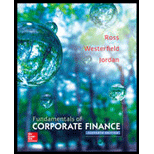
Concept explainers
Case summary:
Person M and Person T are the owners of Company S. They have planned to expand their business. Hence, they asked Person C, the financial analyst to identify an underwriter who would help the company to raise $35,000,000 through a 10-year bond issue. Person C decided that Company R would be the underwriter of the issue. Person C met Person R from Company R and discussed about the bond issue and the features of the bond.
Although Person C was aware of the bond features, he or she was not aware of the effect of those features on the coupon rate and the cost and benefits of those features. Hence, Person R asked his or her assistant, Person X to prepare a memo regarding the effect of bond features on the coupon rate and the cost and benefits of those features.
Characters in the case:
- Company S: The firm issuing bonds
- Person M: Co-owner of Company S
- Person T: Co-owner of Company S
- Person C: Financial analyst of Company S
- Company R: The underwriter
- Person R: The employee of Company R
- Person X: Person R’s assistant
To determine: The effect of floating-rate coupon, and its advantages and disadvantages
Want to see the full answer?
Check out a sample textbook solution
Chapter 7 Solutions
Fundamentals of Corporate Finance
- What is the primary purpose of diversification in a portfolio? a) To maximize returnsb) To reduce riskc) To increase leveraged) To focus on a single asset classarrow_forwardI need help! A company’s weighted average cost of capital (WACC) is used to: A) Determine the average cost of producing goods B) Evaluate the return on investment projects C) Estimate the company's growth rate D) Measure the level of debt in the companyarrow_forwardNeed help!! What does the term "liquidity" refer to in finance? A) The ability to convert assets into cash quickly without significant loss of value B) The ability to increase company profits C) The level of debt in the company D) The diversity of the investment portfolioarrow_forward
- I need answer step by step. A company’s weighted average cost of capital (WACC) is used to: A) Determine the average cost of producing goods B) Evaluate the return on investment projects C) Estimate the company's growth rate D) Measure the level of debt in the companyarrow_forwardDon't use ai A company’s weighted average cost of capital (WACC) is used to: A) Determine the average cost of producing goods B) Evaluate the return on investment projects C) Estimate the company's growth rate D) Measure the level of debt in the companyarrow_forwardA company’s weighted average cost of capital (WACC) is used to: A) Determine the average cost of producing goods B) Evaluate the return on investment projects C) Estimate the company's growth rate D) Measure the level of debt in the companyarrow_forward
- I need help! Which of the following best defines "diversification" in investment? A) Investing in a single type of asset for high returns B) Spreading investments across different assets to reduce risk C) Putting all funds into low-risk bonds D) Focusing on high-risk, high-return investmentsarrow_forwardWhich of the following best defines "diversification" in investment? A) Investing in a single type of asset for high returns B) Spreading investments across different assets to reduce risk C) Putting all funds into low-risk bonds D) Focusing on high-risk, high-return investmentsarrow_forwardWhich of the following best describes the "efficient market hypothesis"? A) Stocks are always priced higher than their actual value. B) It is impossible to outperform the market consistently due to all information being already reflected in stock prices. C) Only insider information can help outperform the market. D) The market reacts slowly to new information.arrow_forward
- The "time value of money" concept states that: A) Money today is worth more than the same amount in the future B) Money tomorrow is worth more than today’s money C) Money and time have no relation in financial decisions D) Time has no impact on financial investmentsarrow_forwardI need help. If net income is $25,000 and total equity is $125,000, what is the return on equity (ROE)?A. 10%B. 15%C. 20%D. 25%arrow_forwardI need help!!Which of the following is NOT a type of financial market? A) Capital Market B) Money Market C) Labor Market D) Commodity Marketarrow_forward
 Intermediate Accounting: Reporting And AnalysisAccountingISBN:9781337788281Author:James M. Wahlen, Jefferson P. Jones, Donald PagachPublisher:Cengage Learning
Intermediate Accounting: Reporting And AnalysisAccountingISBN:9781337788281Author:James M. Wahlen, Jefferson P. Jones, Donald PagachPublisher:Cengage Learning Cornerstones of Financial AccountingAccountingISBN:9781337690881Author:Jay Rich, Jeff JonesPublisher:Cengage Learning
Cornerstones of Financial AccountingAccountingISBN:9781337690881Author:Jay Rich, Jeff JonesPublisher:Cengage Learning


